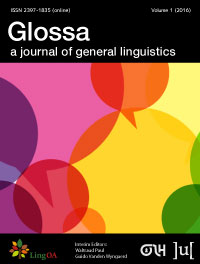永久开放
【每日期刊】Glossa(《语言》)2020年第5卷第1期132篇论文合集
2805 阅读 182 下载 2021-01-03 11:07:19 上传 118.4 MB
本期推送的是SSCI期刊——Glossa(《语言》)2020年第5卷第1期共132篇论文。该资源永久有效,请点击文末按钮下载。
Glossa(《语言》)2020年第5卷第1期132篇论文合集

| 序号 | 类型 | 作者 | 题目 |
| 01 | Article | Hammond et al. | Category-specific effects in Welsh mutation |
| 02 | Article | Murphy | Language design and communicative competence: The minimalist perspective |
| 03 | Article | van Kemenade & Links | Discourse particles in early English: Clause structure, pragmatics and discourse management |
| 04 | Article | Issah & Smith | Subject and non-subject ex-situ focus in Dagbani |
| 05 | Article | Zaitsu | Modality force and syntax in an understudied class of reduced why-questions in English |
| 06 | Article | Baumann & Schumacher | The incremental processing of focus, givenness and prosodic prominence |
| 07 | Article | Albu | Not Known: Anonymous, Unknown or Non-known? A pilot test on the interpretation of negated absolute adjectives in Romanian |
| 08 | Article | Alshaalan & Abels | Resumption as a sluicing source in Saudi Arabic: Evidence from sluicing with prepositional phrases |
| 09 | Article | Suarez-Palma | Applied arguments in Spanish inchoative middle constructions |
| 10 | Article | Bye | Expressive Sibilant Retraction in North Norwegian: morpheme or ‘spoken gesture’? |
| 11 | Article | Russo & Ulfsbjorninn | Initial lenition and strength alternations (v/b) in Neapolitan: A laryngeal Branchingness condition |
| 12 | Article | Homer & Bhatt | Restructuring and the scope of negation in Hindi-Urdu |
| 13 | Squib | Messick | The derivation of highest subject questions and the nature of the EPP |
| 14 | Article | Patil | Constraints on German diese demonstratives: language formality and subject-avoidance |
| 15 | Article | Bruening | The head of the nominal is N, not D: N-to-D Movement, Hybrid Agreement, and conventionalized expressions |
| 16 | Article | Sigurðsson & Wood | “We Olaf”: Pro[(x-)NP] constructions in Icelandic and beyond |
| 17 | Article | Davis | Crossing and stranding at edges: On intermediate stranding and phase theory |
| 18 | Squib | Harbour | Conjunction resolution is nonsyntactic, say paucals |
| 19 | Article | Jamieson | Viewing dialect change through acceptability judgments: A case study in Shetland dialect |
| 20 | Article | Zyman & Kalivoda | XP- and X0-movement in the Latin verb: Evidence from mirroring and anti-mirroring |
| 21 | Article | Pañeda et al. | Island effects in Spanish comprehension |
| 22 | Article | Pineda & Berro | Hybrid intransitives in Basque |
| 23 | Article | Wyngaerd | How to be positive |
| 24 | Article | Smith & Pater | French schwa and gradient cumulativity |
| 25 | Article | Brandner | A “borderline case” of syntactic variation |
| 26 | Article | Little | Left branch extraction, object shift, and freezing effects in Tumbalá Ch’ol |
| 27 | Article | Franck et al. | Object attraction and the role of structural hierarchy: Evidence from Persian |
| 28 | Article | Varaschin | Anti-reflexivity and logophoricity: an account of unexpected reflexivization contrasts |
| 29 | Article | Martin & Piñón | Verbalizing nouns and adjectives: The case of behavior-related verbs |
| 30 | Squib | Zyman | In situ mixed wh-coordination and the argument/adjunct distinction |
| 31 | Article | Lyskawa | The structure of Polish numerically-quantified expressions |
| 32 | Article | Ahyad & Becker | Vowel unpredictability in Hijazi Arabic monosyllabic verbs |
| 33 | Squib | Estigarribia | A biclausal account of Clitic Left-Dislocations with epithets in Rioplatense Spanish |
| 34 | Article | Faller | The many functions of Cuzco Quechua =pas: implications for the semantic map of additivity |
| 35 | Squib | Feiman et al. | Priming quantifier scope: Reexamining the evidence against scope inversion |
| 36 | Article | Fernández-Salgueiro | On EPP effects and the properties of Core Functional Categories |
| 37 | Article | Liu | A morpheme introducing degrees and its impact on argument structure: The Taiwanese Southern Min u- |
| 38 | Article | Contemori & Dussias | The processing of subject pronouns in highly proficient L2 speakers of English |
| 39 | Article | Baker & Condo | Possession and nominalization in Dan: Evidence for a general theory of categories |
| 40 | Article | Connelly & Cowper | Gender diversity and morphosyntax: An account of singular they |
| 41 | Article | Toquero-Pérez | The semantics of Spanish compounding: An analysis of NN compounds in the Parallel Architecture |
| 42 | Article | De Belder | A split approach to the selection of allomorphs: Vowel length alternating allomorphy in Dutch |
| 43 | Article | De Bastiani & Hinterhölzl | On the syntax of object pronouns in Old English and Early Middle English |
| 44 | Squib | van Alem | Complementizer agreement is not allomorphy: A reply to Weisser (2019) |
| 45 | Article | Karjus et al. | Challenges in detecting evolutionary forces in language change using diachronic corpora |
| 46 | Squib | Kalinin | Gapping is not only low coordination |
| 47 | Squib | Bross & Fraser | Contrastive focus reduplication and the modification puzzle |
| 48 | Article | Natvig | Rhotic underspecification: Deriving variability and arbitrariness through phonological representations |
| 49 | Article | Nadthur & Lauer | Causal necessity, causal sufficiency, and the implications of causative verbs |
| 50 | Article | Blochowiak et al. | What type of subjectivity lies behind French causal connectives? A corpus-based comparative investigation of car and parce que |
| 51 | Article | Gutzmann et al. | Verum focus is verum, not focus: Cross-linguistic evidence |
| 52 | Article | Parker | Vestigial ergativity in Shughni: At the intersection of alignment, clitic doubling, and feature-driven movement |
| 53 | Article | Iordăchioaia | D and N are different nominalizers |
| 54 | Article | Burukina | Mandative verbs and deontic modals in Russian: Between obligatory control and overt embedded subjects |
| 55 | Article | Margaza & Gavarró | Null/overt subject alternations in L2 Spanish and L2 Greek |
| 56 | Article | Avcu & Hestvik | Unlearnable phonotactics |
| 57 | Article | Hosemann et al. | Signs activate their written word translation in deaf adults: An ERP study on cross-modal co-activation in German Sign Language |
| 58 | Article | Mitrović & Panagiotidis | Adjectives exist, adjectivisers do not: a bicategorial typology |
| 59 | Article | Wolfe | Reconsidering variation and change in the Medieval French subject system |
| 60 | Article | Schlenker | Inside out: A note on the hierarchical update of nominal modifiers |
| 61 | Article | Batllori & Sitaridou | Fronting in Old Spanish |
| 62 | Article | Newman | Facilitator effects in middles and more |
| 63 | Article | Bross | Object marking in German Sign Language (Deutsche Gebärdensprache): Differential object marking and object shift in the visual modality |
| 64 | Squib | Bross | The why-how alternation and a new test for sentential negation—on negated how-questions |
| 65 | Article | Eynde | Agreement, disagreement and the NP vs. DP debate |
| 66 | Article | Garellek | Phonetics and phonology of schwa insertion in Central Yiddish |
| 67 | Article | Jaker | On the historical source of a ~ u alternations in Dëne Sųłıné optative paradigms |
| 68 | Article | Preminger | Functional structure in the noun phrase: revisiting Hebrew nominals |
| 69 | Article | Höhn | The third person gap in adnominal pronoun constructions |
| 70 | Article | Hoot et al. | Object focus marking in Spanish: An investigation using three tasks |
| 71 | Article | Fotiadou et al. | Anaphora resolution and word-order across adulthood: Ageing effects on online listening comprehension |
| 72 | Article | Marty et al. | The effect of three basic task features on the sensitivity of acceptability judgment tasks |
| 73 | Article | Mandal et al. | Bilingual phonology in dichotic perception: A case study of Malayalam and English voicing |
| 74 | Article | Lahrouchi | Not as you R: Adapting the French rhotic into Berber |
| 75 | Article | Giannakou & Sitaridou | Microparametric variation in the syntax of Spanish and Greek pronominal subjects |
| 76 | Article | Baerman | Gender flip and person marking in Benchnon (North Omotic) |
| 77 | Article | Grant et al. | Processing ambiguities in attachment and pronominal reference |
| 78 | Article | Bosnić | Dancing monkeys in Serbian and Korean – exhaustivity requirements on distributive share markers |
| 79 | Squib | Rudnev | The Anaphor Agreement Effect is not about featural deficiency: Evidence from Avar |
| 80 | Article | Nikolaeva | Constructional analogy and reanalysis in possessive applicatives |
| 81 | Article | Oikonomou et al. | Quantifier scope and information structure in Greek |
| 82 | Article | Hauser & Hughto | Analyzing opacity with contextual faithfulness constraints |
| 83 | Article | Salzmann | The NP vs. DP debate. Why previous arguments are inconclusive and what a good argument could look like. Evidence from agreement with hybrid nouns |
| 84 | Article | Erlewine | Anti-locality and subject extraction |
| 85 | Article | Klockmann | The article a(n) in English quantifying expressions: A default marker of cardinality |
| 86 | Article | Faghiri & Samvelian | Word order preferences and the effect of phrasal length in SOV languages: evidence from sentence production in Persian |
| 87 | Article | Tonhauser et al. | Evaluative adjective sentences: A question-based analysis of projection |
| 88 | Article | Ferrara | Some interactional functions of finger pointing in signed language conversations |
| 89 | Article | Sauerland et al. | When hypotaxis looks like parataxis: embedding and complementizer agreement in Teiwa |
| 90 | Article | Angelopoulos et al. | Greek and English passives, and the role of by-phrases |
| 91 | Article | Sandstedt | A reanalysis of abstract contrasts and opacity in Bondu-so tongue root harmony |
| 92 | Article | Citko & Gračanin-Yuksek | Conjunction saves multiple sluicing: How *(and) why? |
| 93 | Article | Ozarkar | A special case of long distance agreement in Marathi |
| 94 | Squib | Pham et al. | Investigating the relationship between individual differences and island sensitivity |
| 95 | Article | Torregrossa et al. | Variation in the use and interpretation of null subjects: A view from Greek and Italian |
| 96 | Article | Schaefer | The morpho-syntactic encoding of discourse-linked topics: an agreement alternation in inversion in North-Eastern Italian varieties |
| 97 | Article | Martin et al. | Experimental evidence for the influence of structure and meaning on linear order in the noun phrase |
| 98 | Article | Panizza & Sudo | Minimal sufficiency with covert even |
| 99 | Squib | Villa-García & Rodríguez | Dialectal variation in the expression of que in sí-que ‘yes that’ contexts across Spanish: The case of some Latin American Spanish varieties |
| 100 | Article | Meyer et al. | Many systems, one strategy: Acquiring ordinals in Dutch and English |
| 101 | Article | Pasquereau | Polar response particles in French as remnants of ellipsis |
| 102 | Article | Tebay & Zimmermann | Exceptionality in Assamese vowel harmony: A phonological account |
| 103 | Article | Willis | Using social-media data to investigate morphosyntactic variation and dialect syntax in a lesser-used language: Two case studies from Welsh |
| 104 | Article | Ginzburg et al. | Laughter as language |
| 105 | Article | White & Raulins | Frequency, acceptability, and selection: A case study of clause-embedding |
| 106 | Article | Driemel | Pseudo-incorporation and its movement patterns |
| 107 | Article | Kaur | On the syntax of addressee in imperatives: insights from allocutivity |
| 108 | Article | Bross | Encoding different types of topics and foci in German Sign Language. A cartographic approach to sign language syntax |
| 109 | Article | Bondarenko | Factivity from pre-existence: Evidence from Barguzin Buryat |
| 110 | Article | Frey | German concessives as TPs, JPs and ActPs |
| 111 | Article | Tellings | An analysis of all-clefts |
| 112 | Article | Green et al. | Processing adjunct control: Evidence on the use of structural information and prediction in reference resolution |
| 113 | Article | Kratzer & Selkirk | Deconstructing information structure |
| 114 | Article | Schoenmakers | Freedom in the Dutch middle-field: Deriving discourse structure at the syntax-pragmatics interface |
| 115 | Article | De Cia | Apparent wh-in-situ in Bellunese: Microparametric variation in the locus of subject clitic inversion |
| 116 | Article | Haida & Trinh | Zero and triviality |
| 117 | Article | Domenico et al. | Null and overt subject pronouns in topic continuity and topic shift: An investigation of the narrative productions of Italian Natives, Greek Natives and near-native second language speakers of Italian with Greek as a first language |
| 118 | Article | Giomi | Headedness and modification in Functional Discourse Grammar |
| 119 | Article | Montrul & Bateman | Vulnerability and stability of Differential Object Marking in Romanian heritage speakers |
| 120 | Article | Yates & Gluckman | Voice Reversals and Syntactic Structure: Evidence from Hittite |
| 121 | Article | Bermúdez-Otero | The initiation and incrementation of sound change: Community-oriented momentum-sensitive learning |
| 122 | Article | Moulton et al. | Singular they in context |
| 123 | Article | Fraga | Spanish prepositions and silent PLACE |
| 124 | Article | Gribanova | Predicate formation and verb-stranding ellipsis in Uzbek |
| 125 | Article | Becker & Schneider-Blum | Morphological marking of contrast in Tima |
| 126 | Article | Monforte | Syntactic analyses of discourse particles through the microvariation of Basque ote |
| 127 | Article | Saab | Deconstructing Voice. The syntax and semantics of u-syncretism in Spanish |
| 128 | Article | Fritz-Huechante | Agentivity and non-culminating causation in the psych domain: Cross-linguistic evidence from Spanish and Korean |
| 129 | Article | Sudo & Spathas | Gender and interpretation in Greek: Comments on Merchant (2014) |
| 130 | Article | Iosad & Lamb | Dialect variation in Scottish Gaelic nominal morphology: A quantitative study |
| 131 | Article | Roehrs | The morpho-syntax of phrasal proper names in German |
| 132 | Article | Haddad | Vocatives as parenthetical adjuncts: Evidence from Arabic |
所需积分:0 分
永久开放
相关工具
表情
图片
附件
0
发布
0
订阅
0
工具
1.8万
被阅读( 昨日+4)














